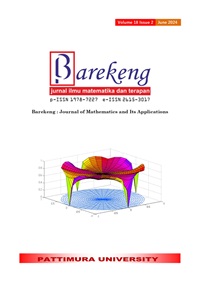OPTIMAL CONTROL ANALYSIS OF HIV/AIDS DISEASE SPREAD MODEL IN INDONESIA
Abstract
The Human Immunodeficiency Virus (HIV) is a contagious virus that weakens the immune system of infected individuals, making them more susceptible to various diseases. These individuals are referred to as those exposed to the AIDS disease, which unfortunately, cannot be cured. To effectively manage AIDS, prevention is crucial in slowing down the spread and growth of the HIV virus. Mathematical modeling can play a significant role in the optimal control of AIDS. In this study, the , , , , model with three different optimal controls were employed. Optimal control involves public health education campaigns, screening, and treatment. The goal is to minimize the number of individuals infected with HIV/AIDS using Pontryagin's Maximum Principle. This principle considers various factors, such as population class coefficients, cost weights, and control variables to determine the most effective approach. The simulation results indicate that counseling control in the exposed population class ( ) yields better outcomes compared to counseling control in the susceptible class and treatment control in the HIV-infected population class. This implies that focusing on educating and counseling individuals who are exposed to HIV can be more efficient in AIDS control than targeting those already infected or at risk. By applying these optimal control strategies, it may be possible to mitigate the impact of HIV/AIDS and improve public health outcomes.
Downloads
References
Z. A. Leleury, F. Y. Rumlawang, and A. G. Naraha, “Analisis Stabilitas dan Simulasi Model Penyebaran Penyakit HIV/AIDS Tipe SIA (Susceptible, Infected, Abstained),” 2020.
A. Mastroberardino, Y. Cheng, A. Abdelrazec, and H. Liu, “MATHEMATICAL MODELING OF THE HIV/AIDS EPIDEMIC IN CUBA,” 2014.
Y. Achdou, M. Laurière, and P.-L. Lions, “Optimal control of conditioned processes with feedback controls,” Dec. 2019, [Online]. Available: http://arxiv.org/abs/1912.08738
F. B. Agusto and A. I. Adekunle, “Optimal control of a two-strain tuberculosis-HIV/AIDS co-infection model,” Biosystems, vol. 119, no. 1, pp. 20–44, May 2014, doi: 10.1016/J.BIOSYSTEMS.2014.03.006.
2023 UNAIDS/WHO estimates, “HIV data and statistics,” HIV data and statistics.
Kementerian kesehatan RI, “Laporan Eksekutif Perkembangan HIV AIDS Dan Penyakit Infeksi Menular Seksual (Pims) Triwulan Ii Tahun 2022,” Jakarta, Jun. 2022.
P. K. Roy, S. Saha, and F. Al Basir, “Effect of awareness programs in controlling the disease HIV/AIDS: an optimal control theoretic approach,” Adv Differ Equ, vol. 2015, no. 1, Dec. 2015, doi: 10.1186/s13662-015-0549-9.
O. Zakary, M. Rachik, and I. Elmouki, “On the impact of awareness programs in HIV/AIDS prevention: an SIR model with optimal control,” Article in International Journal of Computer Applications, vol. 133, no. 9, pp. 975–8887, 2016, doi: 10.5120/ijca2016908030.
Marsudi, N. Hidayat, and R. B. E. Wibowo, “Optimal strategy for controlling the spread of HIV dynamics with educational campaigns and antiretroviral therapy,” J Phys Conf Ser, vol. 1028, no. 1, p. 012115, Jun. 2018, doi: 10.1088/1742-6596/1028/1/012115.
N. Shofianah, S. Fitri, Trisilowati, and K. T. Kristanti, “Optimal Control of HIV/AIDS Epidemic Model with Two Latent Stages, Vertical Transmission and Treatment,” in Journal of Physics: Conference Series, Institute of Physics Publishing, Jun. 2020. doi: 10.1088/1742-6596/1562/1/012017.
K. R. Cheneke, “Optimal Control and Bifurcation Analysis of HIV Model,” Comput Math Methods Med, vol. 2023, 2023, doi: 10.1155/2023/4754426.
Marsudi, Trisilowati, A. Suryanto, and I. Darti, “Optimal Control of an HIV Model with Changing Behavior through an Education Campaign, Screening and Treatment,” in IOP Conference Series: Materials Science and Engineering, Institute of Physics Publishing, Jul. 2019. doi: 10.1088/1757-899X/546/5/052043.
N. H. Sweilam, S. M. AL-Mekhlafi, Z. N. Mohammed, and D. Baleanu, “Optimal control for variable order fractional HIV/AIDS and malaria mathematical models with multi-time delay,” Alexandria Engineering Journal, vol. 59, no. 5, pp. 3149–3162, Oct. 2020, doi: 10.1016/J.AEJ.2020.07.021.
M. Shirazian and M. H. Farahi, “Optimal Control Strategy for a Fully Determined HIV Model,” Intelligent Control and Automation, vol. 1, pp. 15–19, 2010, doi: 10.4236/ica.201.11002.
H. D. Kwon, J. Lee, and S. D. Yang, “Optimal control of an age-structured model of HIV infection,” Appl Math Comput, vol. 219, no. 5, pp. 2766–2779, Nov. 2012, doi: 10.1016/J.AMC.2012.09.003.
M. H. A. Biswas, L. T. Paiva, and M. De Pinho, “A seir model for control of infectious diseases with constraints,” Mathematical Biosciences and Engineering, vol. 11, no. 4, pp. 761–784, 2014, doi: 10.3934/mbe.2014.11.761.
P. A. Naik, J. Zu, and K. M. Owolabi, “Global dynamics of a fractional order model for the transmission of HIV epidemic with optimal control,” Chaos Solitons Fractals, vol. 138, p. 109826, Sep. 2020, doi: 10.1016/J.CHAOS.2020.109826.
B. Ulfa and W. Muharini Kusumawinahyu, “Dynamical Analysis of HIV/AIDS Epidemic Model with Treatment,” Life Sci, vol. 8, no. 1, 2018.
Copyright (c) 2024 Wika Dianita Utami, Ahmad Naufal Dzaky, Aris Fanani

This work is licensed under a Creative Commons Attribution-ShareAlike 4.0 International License.
Authors who publish with this Journal agree to the following terms:
- Author retain copyright and grant the journal right of first publication with the work simultaneously licensed under a creative commons attribution license that allow others to share the work within an acknowledgement of the work’s authorship and initial publication of this journal.
- Authors are able to enter into separate, additional contractual arrangement for the non-exclusive distribution of the journal’s published version of the work (e.g. acknowledgement of its initial publication in this journal).
- Authors are permitted and encouraged to post their work online (e.g. in institutional repositories or on their websites) prior to and during the submission process, as it can lead to productive exchanges, as well as earlier and greater citation of published works.






1.gif)



